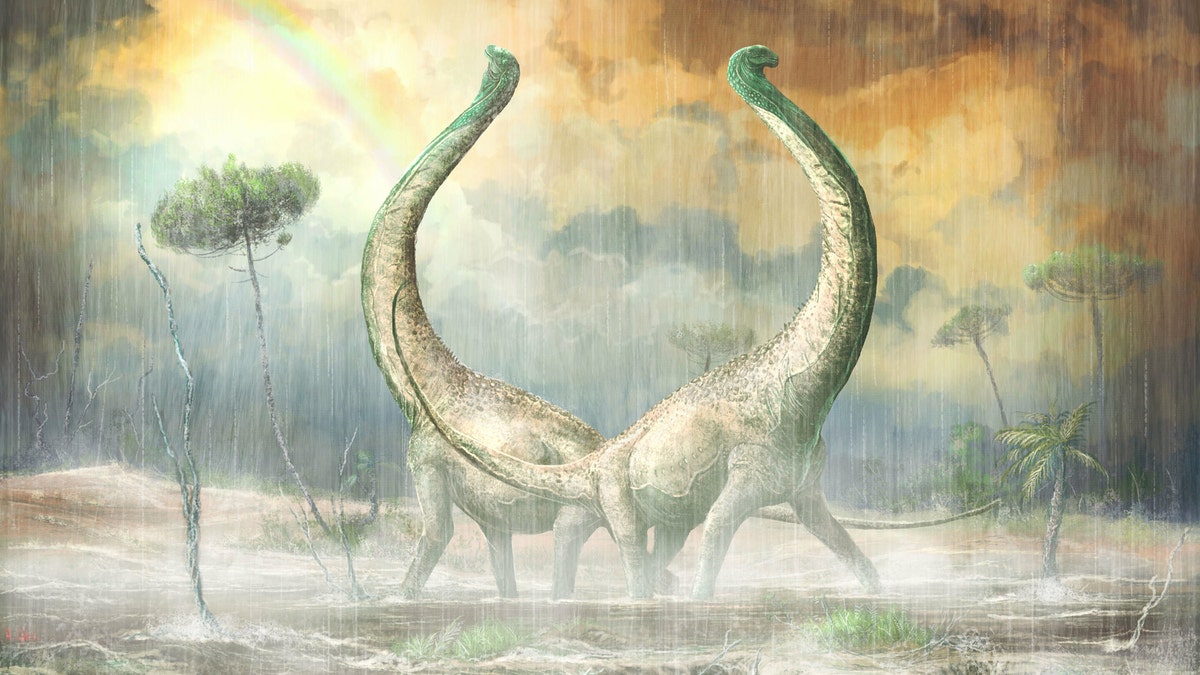
Illustration depicting Mnyamawamtuka in its environmental setting. (Credit: Mark Witton)
With perhaps no coincidence that today is Valentine's Day, a new dinosaur has been found with a "heart-shaped tail."
Known as Mnyamawamtuka moyowamkia ("beast of the Mtuka" and "heart of the tail," in Swahili), the titanosaur was discovered on the cliffs of Tanzania. Researchers were able to find a significant amount of fossilized bones and teeth, including a heart-shaped tail vertebra, which has sparked curiosity.
"This new dinosaur gives us important information about African fauna during a time of evolutionary change," said Judy Skog, a program director in the National Science Foundation's Division of Earth Sciences, which funded the research, in a statement. "The discovery offers insights into paleogeography during the Cretaceous. It's also timely information about an animal with heart-shaped tail bones during this week of Valentine's Day."
NEW DINOSAUR SPECIES WITH SPIKY BACKBONE DISCOVERED IN ARGENTINA: REPORT
Fossils of the ancient beast were first discovered in 2004 and it took several seasons for a full extraction (2008, to be precise) of the Cretaceous-era bones. Given that not much is known about titanosaurs, which are thought to have weighed as much as 76 tons, the findings may prove immensely valuable, Dr. Eric Gorscak, the study's lead author, said.
"Although titanosaurs became one of the most successful dinosaur groups before the infamous mass extinction capping the Age of Dinosaurs, their early evolutionary history remains obscure, and Mnyamawamtuka helps tell those beginnings, especially for their African-side of the story," said Gorscak in the statement.
"The wealth of information from the skeleton indicates it was distantly related to other known African titanosaurs, except for some interesting similarities with another dinosaur, Malawisaurus, from just across the Tanzania-Malawi border," Gorscak added.
It's likely that the titanosaur was "fairly young, like a teenager maybe," when it died, Gorscake said in an interview with LiveScience. There are no teeth marks, suggesting it was not eaten, but it likely died a quick death, as noted by the large number of preserved bones.

Illustration depicting the 'heart tail' from Mnyamawamtuka moyowamkia and a selection of the recovered bones from its skeleton. (Credit: Mark Witton)
"The new specimen preserves teeth, elements from all regions of the postcranial axial skeleton, parts of both appendicular girdles, and portions of both limbs including a complete metatarsus," the study's abstract reads. The research was published in the scientific journal PLOS One.
Titanosaurs are best known from South America, but the newly discovered species in Tanzania, as well as other parts of Africa, show that the dino was more diverse than previously thought.
FIRST DINOSAUR FEATHER EVER DISCOVERED REVEALS MYSTERIOUS SECRETS
"The discovery of dinosaurs like Mnyamawamtuka and others we have recently discovered is like doing a four-dimensional connect the dots," said Dr. Patrick O'Connor, professor of anatomy at Ohio University, in the statement.
"Each new discovery adds a bit more detail to the picture of what ecosystems on continental Africa were like during the Cretaceous, allowing us to assemble a more holistic view of biotic change in the past," O'Connor added.
